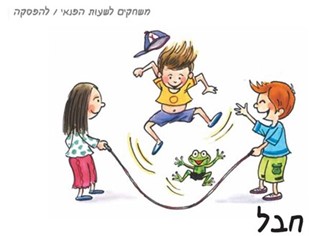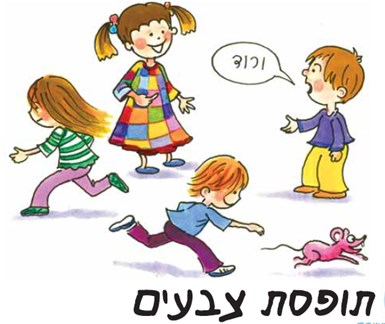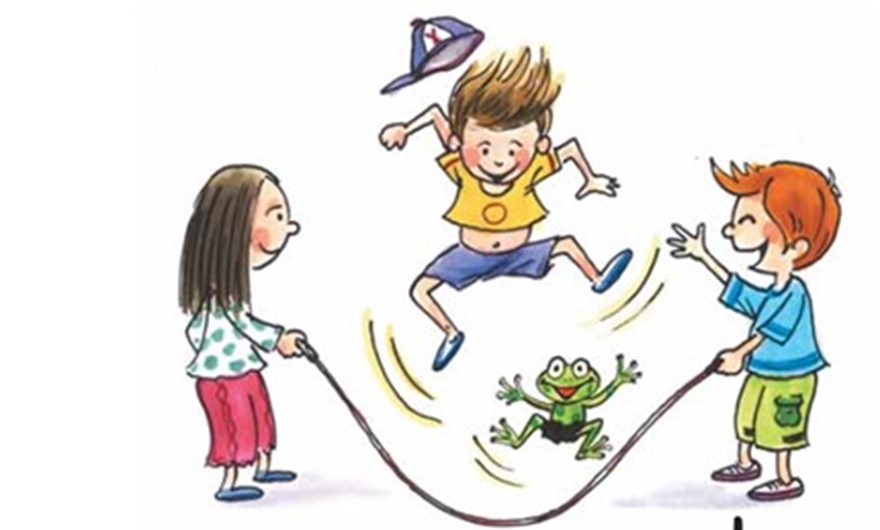Games for recreation / recess
Jump Rope
Physical activity, especially with the kids, does not have to be planned or scheduled – often it can be a dare, an excuse to bond and particularly to have fun. In the “Games From Olden Days” guide, you’ll be able to find ideas such as hopscotch, dodgeball and more, directly from the days when there were much fewer displays, and during school recess, children went outside to play in the yard, and didn’t wait for the first chance to turn on their smartphones.
Physical activity has many important benefits for children
- It improves balance and coordination
- It develops social and communication skills
- It’s fun and makes you feel happy and strong
- Physical activity enhances abilities to study and concentrate, also creativity and willingness to try new things
The Ministry of Education’s National Board of Physical Education has published a book with 60 childhood games from olden days. The games were divided into six categories, ten games in each category: ball games, games for developing fine motor skills, games for improving physical fitness, social games, games for school recess and games for large groups.
Full book - Classic Games - 60 Years of Play (in Hebrew)
Below are a few examples of the games.
These games are brought to the EfshariBari site in partnership with the National Service of Occupational Therapy (in Hebrew) at the Ministry of Health.
Game - Jump rope

| Target audience |
Grades 1-6, middle school |
| Conditions & required accessories |
Long rope (more than 0.5 meters) |
| Goals |
Skipping through a turning rope |
| Educational goals |
Skipping, jumping, strengthening leg muscles, coordination and team work |
| How to play |
- Two players hold the rope at each end. They turn the rope in a circular motion and sing a song.
- On cue, a third player jumps in coordination with the turning rope.
- As soon as the jumping player calls out the name of another player, the first player exits and is replaced by the next one.
- Continue without tripping over the rope.
|
| Difficulty levels |
- Two players jump at the same time.
- More players added.
- Addition of another rope turning in the opposite direction of the first rope.
|
Game - Jumpsies

| Target audience |
Preschool, grades 1-6 |
| Conditions & required accessories |
2-2.5 meters elastic |
| Goals |
Jumping on the elastic and with the elastic without making a mistake / being disqualified |
| Educational goals |
Improving skipping, jumping, agility and coordination |
| How to play |
- Players are divided into groups of three. Two stand with legs apart with the elastic around their legs.
- A third player, the jumper, enters into the middle of the elastic, jumps into the air and lands with both feet on one side of the elastic, jumps again, spreading his/her legs and landing with the elastic between his/her legs, then turns 45 degrees and jumps back in between the lengths of elastic.
- The process is repeated on the other side of the elastic.
- After completing both sides, the player jumps out of the elastic, landing with both feet together
|
| Difficulty levels |
After the jumping player has successfully completed their turn, the elastic is raised for the next level (the elastic is placed higher):
- First level – elastic on the ankles
- Second stage – elastic on the calf
- Third stage – elastic behind the knee
- Forth stage – elastic behind the middle of the thigh
- Fifth stage – elastic on the hips
- Sixth stage – all previous stages on one foot
A disqualified player replaces one of the players holding the elastic.
|
Game - Hula hoop

| Target audience |
Preschool, grades 1-6, middle school |
| Conditions & required accessories |
Hula hoop for each player |
| Goals |
Twirl the hoop around your waist or arm / leg for as long as possible |
| Educational goals |
Flexibility, coordination, balance |
| How to play |
- Players place the hoop on their waist or arm or leg, supporting it with their hand.
- On a signal, the players twirl the hoop around their waist or arm or leg without hand assistance.
- The winner is the player who twirled longest.
|
| Difficulty levels |
Changes from child to child in accordance with their coordination. |
Game - Chinese scarf game

| Target audience |
Preschool, grades 1-4 |
| Conditions & required accessories |
Ball (soft or sponge) |
| Goals |
Running in a circle |
| Educational goals |
Concentration, speed, quick response, running in a circle |
| How to play |
- Playerssit in a circle with their hands behind their backs.
- One player walks around the outside of the circle holding a small scarf.
- That player suddenly and arbitrarily, places the scarf in the hands of one of the sitting players.
- The player who received the scarf gets up quickly and begins chasing the first player, both running around the circle.
- The first player runs all around the circle once and sits in the space vacated by the player who received the scarf.
- If the chaser catches the chased player before they sit down, the latter sits in the middle of the circle and the game continues.
- If not caught – the chaser becomes the next player to go around the circle holding the scarf.
|
Game - Sea-Land

| Target audience |
Preschool, grades 1-4 |
| Conditions & required accessories |
Hoops |
| Goals |
Perseverance and remaining in the game until the end |
| Educational goals |
Improving jumping, concentration and listening to instructions, quick response |
| How to play |
- Place hoops or draw circles on the ground. One circle for each player.
- When the game coordinator says “sea” – the players are to jump into the hoops, when the coordinator says “land” – they must jump outside the hoops.
- The coordinator tries to confuse the players by making quick calls and the players need to jump to the right position inside or outside the hoop.
- Players who get confused and jump to the wrong position – are disqualified.
- The winner is the last player remaining after the rest have been disqualified.
|
Game - Three sticks

| Target audience |
Grades 1-12 |
| Conditions & required accessories |
Soft surface and three sticks |
| Goals |
Jump between three sticks to the furthest distance |
| Educational goals |
Improving leg strength, speed, practicing the triple jump (running, jumping and landing) |
| How to play |
- The three sticks are arranged at a distance of one step from one another.
- Players line up and jump over the sticks.
- The final player rearranges the sticks at a larger distance from each other.
- Each player must, in their turn, jump over the sticks without touching them.
- After everyone has jumped over the sticks, the final player moves the final stick further apart from the others.
- The second stick must also be moved so the distance between the sticks is equal.
- Players who step on a stick or touched them move ahead to be first in the line of players.
- In the event a player touched or stepped on the sticks twice, they are disqualified.
- The winner is the player that managed to jump the furthest distance between the three sticks without touching them.
- Comment: The last stick will be moved to the spot where the last player landed.
|
Game - Musical chairs

| Target audience |
Preschool, grades 1-4 |
| Conditions & required accessories |
Audio equipment (for listening to music), chairs (one less than the number of players) |
| Goals |
To be the last player sitting on the last chair |
| Educational goals |
Listening and concentration, quick response, speed |
| How to play |
- Chairs are arranged in a line, facing different directions
- Player stand around the chairs and music plays in the background
- While music is playing, players walk around the chairs
- When the music stops – players must quickly sit on the chairs
- The player who did not sit on a chair is disqualified. At this point, a chair is removed from the game (disqualified players can help judge the game)
|
Game - Color catch

| Target audience |
Preschool, grades 1-4 |
| Conditions & required accessories |
No special accessories |
| Goals |
Recognizing an object of the right color and touching it |
| Educational goals |
Speed, agility, color recognition, listening to instructions |
| How to play |
- The player who is ‘it’ declares a color so everyone can hear
- Players must quickly touch an object or item of clothing in the declared color
- The player who is ‘it’ must try to catch a player before they touch the color
- The player caught becomes ‘it’
|
Game - Apartment for rent

| Target audience |
Preschool, grades 1-4 |
| Conditions & required accessories |
Hoops, same number as players |
| Goals |
To remain a ‘tenant’ |
| Educational goals |
Development of quick thinking and speed |
| How to play |
- Each player stands inside an ‘apartment’ (hoop/circle). One player doesn’t have an apartment.
- The player who does not have an apartment must try to get into one.
- This player goes from hoop to hoop and asks “Do you have an apartment for rent?”. While this is occurring, the other players exchange places (‘apartments’) without the ‘homeless’ player taking their place
- A player who doesn’t reach an available apartment on time, becomes the ‘homeless’ player and looks for an apartment for rent.
|
Game - Touchdown

| Target audience |
Grades 3-12 |
| Conditions & required accessories |
Ball and four cones (it is preferable to play outdoors such as a court or space that can be marked by chalking check marks) |
| Goals |
To place the ball over the other team’s line |
| Educational goals |
Throwing and catching a ball, cooperation |
| How to play |
- Players are divided into two groups. Each group plays catch with the ball among their team, with the intent of placing the ball beyond the other team’s defense line or between two cones at the opposing team’s end of the field. Each team gets points for placing the ball across the other team’s line.
- It is not permitted to run with the ball or dribble it.
|
| Difficulty levels |
- A girl must pass to a boy, a boy must pass to a girl.
- Passing to the participant who passed you the ball is not allowed.
- If the ball falls on the floor, it is turned over to the other team.
- Participants are allowed to dribble once or twice before passing.
- Allow participants to run with the ball until they are touched by a member of the other team - then, they must stop and pass the ball to a teammate.
- Limit (reduce) the size of the field of play.
|
Further Reading
Full book - Classic Games - 60 Years of Play (in Hebrew)














